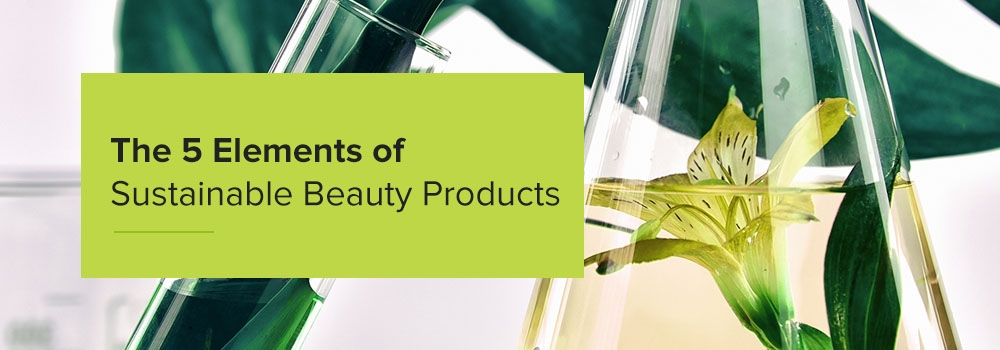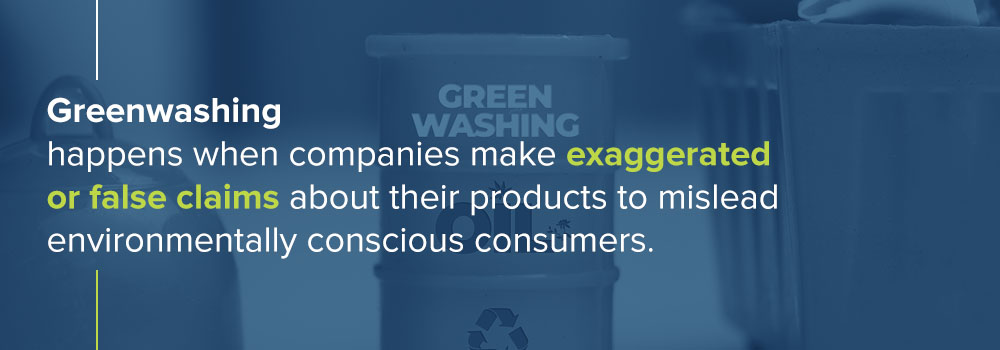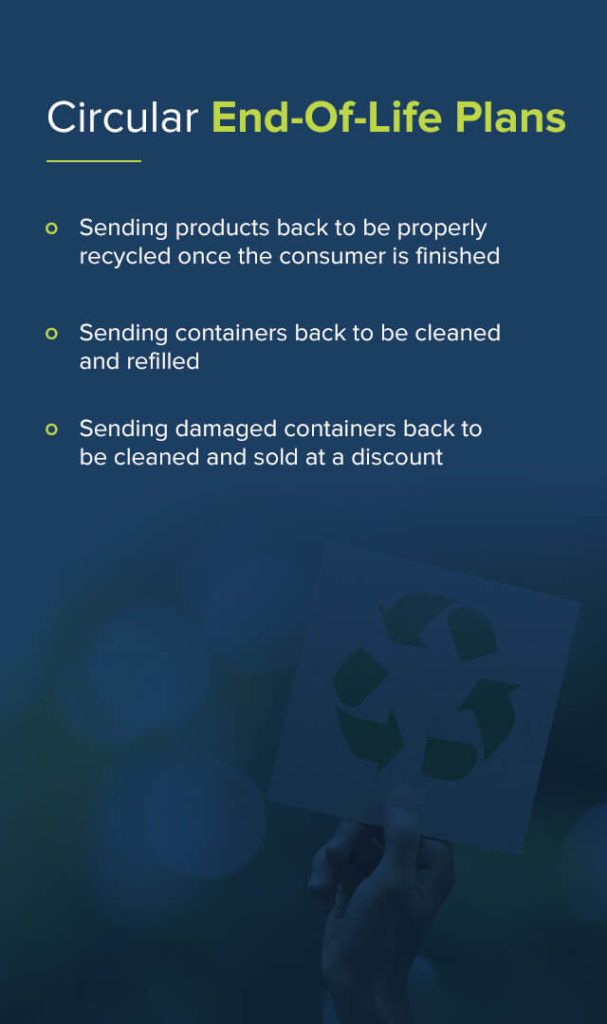The 5 Elements of Sustainable Beauty Products

Jump to:
- What Is Sustainability?
- What Is Greenwashing?
- The 5 Most Important Sustainable Considerations for Beauty Products
- Acme-Hardesty Is Committed to Sustainability
Consumers are more environmentally and ethically conscious than ever. According to Pew Research, 64% of American adults say reducing the effects of climate change should be a top priority. While this ratio differs across partisan lines, the point remains — people care about where their products come from.
This concern is also at the heart of the beauty industry. In a 2020 survey of 20,000 women aged 15-70, 60% said they prioritize sustainability when buying beauty products. Simply put, sustainability is the future of beauty. But what does it really mean to be sustainable?
What Is Sustainability?
In business, sustainability means creating a balance between environmental and company needs that can be maintained for long periods of time. Sustainable practices are based on the assumption that, because natural resources are limited, we need to conserve them.
Consider the recent push toward slow fashion, a movement that rejects overconsumption of cheap clothing in favor of curating a long-lasting collection of high-quality, ethically produced pieces. Buying from sustainable retailers or secondhand stores is about more than just the end product — it supports a healthy production model.
The same is true for the beauty industry. Customers care about both the process and the product. But what’s in it for the company? By establishing yourself as an eco-friendly brand, you could reap the following benefits:
- You’ll be able to reach a wider consumer base.
- Your company will set itself apart as a leader in the industry.
- You’ll cut down on waste while increasing efficiency.
- Your employees will feel like they’re making a difference.
Making tangible steps toward more sustainable production benefits both consumers and the company as a whole.
What Is Greenwashing?
Greenwashing happens when companies make exaggerated or false claims about their products to mislead environmentally conscious consumers. This practice is unethical because it is misleading, and because it takes away from real environmental work that is being done.

To prevent greenwashing, the Federal Trade Commission (FTC) has established the following general rules for companies to follow regarding environmental claims:
- The product must display green claims in plain language on all packaging and advertising. This also includes any qualifications or disclosures to the claim.
- It should be clear whether the claim relates to the product, the packaging or just a portion of either. For example, “Bottle made with 50% recycled plastic.”
- The claim should not exaggerate the product’s environmental impact or benefit.
- All claims made in comparison to competing companies must be backed up with evidence.
Essentially, when creating product labels and advertising, put quantifiable information front and center. Tell the consumer exactly what you are doing to contribute to sustainability in the beauty industry. This can build trust in your brand, demonstrate your impact on the environment and set an example for other companies to follow.
The 5 Most Important Sustainable Considerations for Beauty Products
So where do you start? Here are the five most important things to consider when creating sustainable beauty products:
1. Sustainable Palm Oil
Palm oil is the most popular vegetable oil in the world according to National Geographic. It comes from the African oil palm tree, which is native to West Africa. Commercially grown in Africa and parts of Southeast Asia, it’s also the world’s most efficient oilseed crop, meaning farmers can produce massive amounts of oil from small areas of land. For a quick comparison, for the same amount of soybean, coconut or sunflower oil, palm oil requires 4 to 10 times less land to produce.
Because it’s so efficient, it’s everywhere. Palm oil appears in products across all industries, from lipsticks to snacks to biofuels. And demand for it is increasing by the year. With such rapid growth, many palm oil growers have resorted to harmful business practices.
The Impact of Unsustainable Palm Oil Production
Deforestation is when large swaths of forests are burned down to make way for something else, like palm oil plantations. The rapid disappearance of these rainforests destroys habitats, making already endangered animals like orangutans more vulnerable to poachers and other threats.
Unsustainable palm oil production is also damaging to humans. Indigenous populations living on land razed for oil palm plantations must leave their homes. Often, they end up working on the plantations under poor conditions.
Palm oil can and should be sustainably produced without destroying homes and habitats, which is what the Roundtable on Sustainable Palm Oil (RSPO) advocates.
The Roundtable on Sustainable Palm Oil
Acme-Hardesty is an RSPO member, which means we aim to reform the palm oil industry by making sustainable production the norm rather than the exception. Products that contain RSPO-certified palm oil have been produced on farms that adhere to several key criteria. The RSPO revisits and revises these standards every five years.
Evaluators use the following standards to certify farms:
- Protection of Indigenous peoples and their rights
- Fair, safe working conditions for palm farmers
- Ban on removing primary forests to make way for oil palm plantations
- Protection of native wildlife
- Minimal emissions of greenhouse gases and other pollutants
Choosing to source palm oil from sustainable sources can set your brand apart from others and show a demand for responsibly produced oil. When palm oil producers see that demand is there, they’re more likely to change their ways to meet standards and cater to ethics-minded companies.
2. Responsibly Sourced Natural Ingredients
Just like with palm oil, it matters where your ingredients come from. The whole process, from production to distribution, should reflect an ethical and environmentally conscious approach. Cosmetics and pharmaceutical manufacturers are still in the process of finding alternatives to problematic ingredients, but new and creative solutions are entering the market every year.
Here are a few ingredients that are of special concern, either for their negative impact on the environment or their questionable production methods.
Mica
Mica is a shimmery mineral used in a wide variety of products like mineral foundation, lipsticks and eyeshadows. It’s what gives these products their sparkle, but it’s also used in many matte products. You can even find mica in products like toothpaste and electrical insulators. Mica is a controversial ingredient because it is commonly linked to unethical practices like child labor.
There are two main ways companies are solving this issue — sourcing mica from ethical mines and producing synthetic mica in a lab. While there currently is no certification process for mica mines, the Responsible Mica Initiative requires its member companies to be transparent in mapping their supply chain and adhering to good workplace standards.
Squalene and Squalane
Squalene, an oil derived from shark liver, is a common ingredient in skin care products like sunscreens and moisturizers. The livers of deep-sea sharks are especially rich in squalene because they’re larger than those of other sharks — up to 20% of their total body weight. Squalene can also come from sustainable plant-based sources, like olives.
There’s a common misconception that “squalene” comes from sharks while “squalane” comes from plants. Both spellings actually refer to the same substance. The difference is not in the source, but in the form – squalane is a hydrogenated form of squalene that is safe for use in cosmetics.
Shark squalene is much cheaper than plant squalene. However, sharks, especially deep-sea species, are endangered and are frequently overfished for their livers. Using plant-based squalene, or avoiding it altogether, is a much more sustainable alternative.
Microbeads
Microbeads are small plastic beads used in products like exfoliators and toothpaste. They’re harmful because after being rinsed down the drains, they end up in wild bodies of water like lakes and oceans where fish mistake them for food. These fish, along with the predators that eat them, can suffer intestinal blockage and die off en masse. It becomes a human health concern when we catch those fish and eat them, bringing the plastic back into our own bodies.
The Microbead-Free Waters Act of 2015 prohibits the use of microbeads in rinse-off cosmetics produced in America, but many other countries are still in the process of banning these tiny pollutants.
3. Organic Formulas
In the cosmetics industry, the term “organic” refers to more than just having natural ingredients in the formula — it also refers to the production of those ingredients. The United States Department of Agriculture (USDA) states that products are “organic” as long as they meet the following criteria:
- Minimize use of synthetics in production
- Do not contain genetically modified organisms (GMOs)
- Adhere to the National List of Allowed and Prohibited Substances
- Are produced using methods that conserve biodiversity
- Contain at least 95% organic material
Conventional makeup formulas can contain any number of potentially harmful ingredients from formaldehyde to polyfluoroalkyl and perfluoroalkyl substances (PFAS). These ingredients are especially concerning when you consider how your skin absorbs nutrients. Depending on the concentration of the substance and the condition of the skin, harmful substances can penetrate deep into the tissue and accumulate in the body, causing problems down the road.
Since organic products keep these ingredients out of their formulations in favor of whole, natural ingredients, they are generally safer to use on the skin. Additionally, producing ingredients through organic processes is better for the environment. Organic farming uses fewer pesticides, which can harm both wildlife and consumers. It also reduces soil erosion and pollution.
4. Reusable and Recyclable Packaging
The saying “reduce, reuse and recycle” holds even more weight in the beauty industry, which produces 120 billion units of plastic packaging per year. With 11 million metric tons projected to enter the ocean this year, it’s incredibly important to find more sustainable ways to package products while maintaining that luxurious feel.
Recyclable and Recycled Packaging
Packaging that mixes materials, such as padded envelopes, are difficult to recycle because their different components are so effectively combined. For this reason, they often end up in landfills.
To make your packaging more recyclable, you could try the following:
- Use more recycled materials and fewer virgin materials.
- If you are using mixed components, make sure they are easy to separate.
- Use fewer mixed materials, like paper that is mixed with plastic.
- If you must use plastic, try switching to one that’s biodegradable or compostable.
Using less packaging overall is another great way to reduce your brand’s impact on the environment. You could do this by creating thinner plastic bottles or shipping orders in smaller containers.
Circular End-Of-Life Plans
Traditional manufacturing models resemble a straight line from production to disposal. Circular product life cycle plans, on the other hand, account for what happens beyond the purchase. Some great examples of end-of-life plans include:
- Sending products back to be properly recycled once the consumer is finished
- Sending containers back to be cleaned and refilled
- Sending damaged containers back to be cleaned and sold at a discount

By considering the final stages of a product’s life, you might be able to reduce the waste you produce, thus cutting your own costs and increasing your efficiency. Plus, your customers will feel like they are making an impact by returning products to be reused or recycled.
Reusable Products
While recycling is a step in the right direction, reusing products is an even more reliable way to keep plastics out of landfills. Consumers have shown great interest in reusable products, as the terms “reusable” and “refillable” grew in search popularity last year.
Reusable packaging, like a refillable eyeshadow palette, is more sustainable than a recyclable single-use container. By creating a package you can refill again and again, you’ll cut back on user-generated waste because people won’t have to throw out the whole thing once they’re done. They only need to repurchase the refill and they’re good to go.
5. Reduced Water Usage
Waterless, or anhydrous, beauty began as a trend in South Korea in the mid-2010s. The original idea was to replace water, which is often the top-listed ingredient, with more active ingredients. Water seems like it would be a moisturizing ingredient, but due to its property of evaporation, it actually strips the skin of its natural oils and dehydrates it. Removing water also reduces the need for preservatives in the product, as there is less chance of bacterial contamination.
Because most waterless products come in solid forms like bars and sticks, you need less packaging to protect them. They’re also lighter and denser than products containing water, so you can save on shipping costs as well.
Water gives creamy products their lightweight, spreadable texture, but there are clever ways to swap out water while keeping that smooth feel:
- Water from fruits, which is usually considered a byproduct
- Aloe water
- Synthetic ingredients
- Hyaluronic acid
- Seaweed algae extract
With water scarcity projected to rise in the coming years, developing waterless forms of products — or using less water in the manufacturing and distribution process — is a smart idea.
Acme-Hardesty Is Committed to Sustainability
Sustainability has been at the heart of our company for 75 years, so we know what we’re talking about when we say sustainable beauty begins with natural, responsibly sourced ingredients. From high-quality castor oil to organic glycerine, we have the right ingredients for your cosmetics company. Browse our selection or contact us for more information today!

